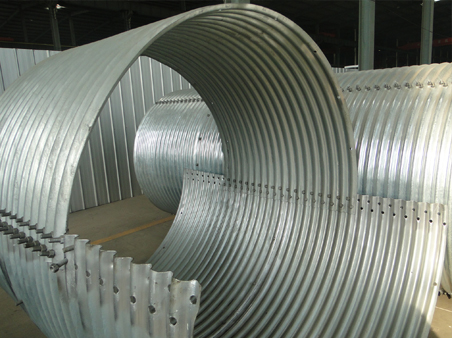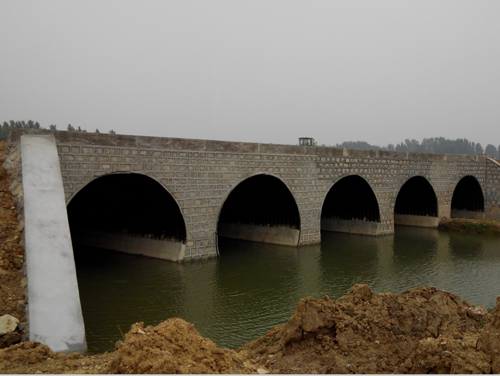Jan. 06, 2023
Corrugated culvert pipe refers to a pipe buried below the ground surface, cast with reinforced concrete, commonly known as cement pipe. Small culverts are also made of metallic materials.
It has the advantages of short construction period, low cost, small disturbance to foundation, low requirement for foundation and good adaptability to deformation. It is especially suitable for road culvert engineering in remote areas and special foundation areas such as permafrost and soft soil.
It is used as a water diversion pipe under the entire section of cofferdam and dam, and it is generally used as a water transfer pipe. At present, the water supply and drainage pipes in most cities in China use cement pipes as culverts.
Metal corrugated culvert pipe is made by corrugating a 2.5-7.0mm thin steel plate surface and rolling it into a pipe joint, which can increase the stiffness of the pipe joint and the resistance strength of the pipe shaft pressure. The resulting culvert is called a bellows culvert. In order to prevent corrosion of the corrugated pipe culvert, the inner and outer surfaces of the corrugated pipe joint and the fastening bolts were hot-dip galvanized, and the average thickness of the galvanized layer was ≥63 μm.
Corrugated pipe culverts have been widely used in foreign highway, railway and building construction projects. Some developed countries not only have factories for manufacturing corrugated pipe joints, but also some countries have issued codes and regulations for the design and construction of corrugated pipe culverts. Before the liberation of China, the highway and railway departments also used corrugated pipe joints imported from abroad. At present, there are factories specializing in the production of corrugated pipes in China. In view of the many advantages of such pipes and culverts, China's steel output has reached the forefront of the world, and the prospects for the promotion and application of corrugated pipes in China are very broad. Contact us about our company.
1. Metal corrugated culvert pipe is a kind of flexible structure, which has the excellent characteristics of lateral displacement compensation. It can give full play to the characteristics of strong tensile performance and excellent deformation performance of steel, and has large anti deformation and anti settlement capacity. It is especially suitable for soft soil, expansive soil, collapsible loess and other areas with low foundation bearing capacity and earthquake prone areas.
2. The construction is simple and the construction period is short (generally, the construction time of a culvert is within one working day), which shortens the exposure time of permafrost, and the amount of freeze-thaw is small, so it is especially suitable for permafrost regions.
3. The damage to the environment is small during construction, which is suitable for areas with fragile ecological environment.
4. The construction only needs to treat the foundation and the import and export, and the amount of sand and stone materials is small, so it is suitable for the areas where sand and stone materials are scarce.
5. The construction only needs a small amount of labor, so it is suitable for the areas with labor shortage.
6. Replacing reinforced concrete in culvert construction is helpful to solve the damage problem of pipe culvert concrete structure in northern cold area in winter, which is suitable for plateau area. www.metalcorrugatedpipe.com
7. Because the standardized design and production are adopted, the design is simple, the production is not affected by the environment, and the centralized factory production is carried out, and the production cycle is short, so it is suitable for the engineering projects with high quality requirements and tight construction period.
8. The technical parameters (wall thickness and waveform) of corrugated metal culvert pipe can be adjusted according to the filling height, so it is suitable for deep and shallow filling area.
Metal corrugated culvert pipe has the advantages of light weight, convenient installation and short construction period. It has been well used in more than 50 highways of all grades in China, and its design service life is 100 years. From the construction period, the construction period of corrugated pipe culvert is only 3-20 days. Compared with reinforced concrete slab culvert and box culvert, the construction period is saved by more than one month, and the social and economic benefits are obvious. It can not only save the construction period and reduce the cost, but also prolong the construction season, speed up the overall progress of the project, and ensure the opening time in advance. The benefit is very significant.
The condition of the infrastructure makes many of our bridge and culvert structures need to be carefully repaired or replaced. In many cases, extending the service life of these culvert structures is an ideal goal worth achieving, freeing up more funds, manpower and available resources for other valuable projects.
Culvert inspection
The first step in any repair, or replacement project is the evaluation and evaluation of the structure in question. The first step is to conduct proper inspections and have a key understanding of the culvert type and material characteristics. When making such assessments, the unique main structural and geometric characteristics of the specific culvert product and the material being studied must be considered. There are many references to help engineers or inspectors with this process. However, some key factors are discussed here.
The key step in properly evaluating any culvert structure is to determine the type of materials used in its manufacture and installation, for example, stone and masonry, reinforced (or non-reinforced) concrete, corrugated metal (steel or aluminum), solid wall steel or iron or plastic (PVC or HDPE). Each culvert material type has a unique set of design and installation standards, as well as applicable standards for proper inspection and evaluation.
Understanding the nuances and differences associated with each culvert material type is very important to accurately assess the adequacy of the structure, estimate the service life, and determine whether the culvert is suitable for repair.

Comply with applicable OSHA requirements and relevant agency guidelines related to confined space entry and inspector safety precautions. Before conducting culvert inspections, assess the risks associated with factors such as surge in water flow, air quality, fall protection, and worker accessibility.
Compare the inspection data with the data found in the previous inspection report. These data include shape changes, blockages, wall loss, perforations, cracks, settlement, seam separation or related problems, road troubles, etc., which can help you find changes or deterioration Conditions in any way. This helps inspectors and engineers determine appropriate measures and assess the relative urgency of any measures that need to be taken.
Measure, record and compare the cross-sectional geometry of culverts to perform shape measurements in previous inspections to check for major changes and establish patterns of movement or deflection.
Pay attention to and study the cracks on the culvert wall, wall cracks or deteriorated sections, joint problems, missing bolts or rivets, and buckling or other visible deformations of the culvert wall to have a potential impact on the structural performance.
Pay attention to and investigate changes in the road surface, guardrails, shoulders and adjacent side fill embankments, as well as changes in the end slopes related to the location of the culvert. For public safety, changes that may affect the integrity of the road should be considered in the inspection.
Since the main purpose of a culvert is to transmit flow, the inspection must consider the hydraulic performance and efficiency of the culvert. Pay attention to and resolve any debris accumulation that will affect the flow capacity of the culvert. Attention should be paid to the destruction of pipes that are upside down at the inlet or outlet ends, as well as the filling loss along the end slope. Both situations may result in loss of filling and support to the culvert and roadway above, and may require attention in the form of impervious walls, slope loops or paving, or other appropriate modifications to the end protection device.
Check the integrity and alignment of the joints. Attention should be paid to open joints to allow a large amount of water to seep out or backfill infiltration, and to mark possible repair methods. Misaligned parts of the pipe affect efficiency and flow rate, and provide a means for infiltration/leakage. Click here to get more information about our products.

Pay attention to and evaluate the effects of wear loss, corrosion, perforation, and similar damage to the culvert material itself or to the coating, so as not to affect the long-term service life and structural performance. Record the presence of abrasives (such as rocks, gravel, sand, and other debris) that may be loaded on the grinding bed. Please note that due to the large number of corrosion products associated with corroded steel, the corrosion seems to be much more serious than it actually is. Usually, after using an abrasive pad to remove this obvious rust, it is found that the "rust" is actually a stain on the culvert wall, and the metal and coating underneath are working as expected. Take core sampling to verify the extent of actual metal loss.
It is recommended that all inspectors be trained in the key aspects of correct culvert inspection and are familiar with the nuances and unique design features of various culvert materials and types used within their scope of responsibility. Such inspections can usually be carried out by agent personnel, but proper knowledge of the functional hydraulics and structural design of specific culvert product types and familiarity with specific installation conditions on site cannot be overemphasized.
There are also companies that specialize in such inspection services and are able to evaluate culverts based on the appropriate set of standards applicable to that particular type of culvert. These companies should be familiar with correct design procedures, standard installation practices, and related factors that affect existing culverts for the type of culvert being studied and evaluated.
Other Blog
 Highway Construction
Highway Construction  Mine Projection
Mine Projection  Municipal Engineering
Municipal Engineering  Irrigation Engineering
Irrigation Engineering  Railway Construction Projection
Railway Construction Projection  Other Application
Other Application Do you need a project solution?
With first-class products and services, and make greater contributions